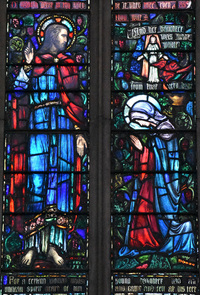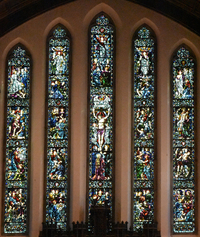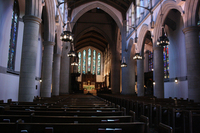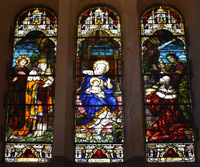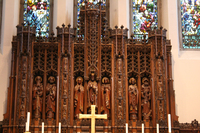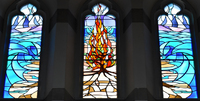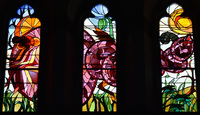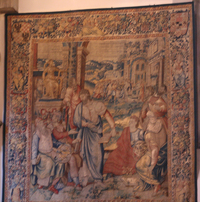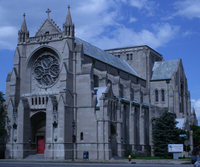MSGC : Featured Windows : Current Window
Featured Windows, February 2009
Cathedral of St. Paul
Building: Cathedral of St. Paul
City: Detroit
State: Michigan
Cathedral of St. Paul, Detroit, MI. Built 1911. Cram, Goodhue and Ferguson, architects.
Many of the early Episcopal churches in large cities possess a
who's who of the late 19th and early 20th century world of stained glass. The Cathedral of St. Paul in Detroit is no exception. The building was designed (1908-1911) by Cram, Goodhue and Ferguson, the famed Boston architectural firm. Architect Ralph Adams Cram is said to have planned the overall theme for the stained glass windows, which eventually included the participation of several fine American and European studios: Charles Connick; J&R Lamb Studio and the William/Henry Willet Studio; from Germany, Mayer Studio; and from England, Powell & Whitefriers and Heaton, Butler and Bayne.
St. Paul’s was designated a state historical property in 1980 and placed on the National Register of Historic Places in 1982. This location is the administrative home for 97 Episcopalian congregations throughout southeast and mid-Michigan, supporting 15 Diocesan-wide social service agencies/programs and chaplains at the University of Michigan, Michigan State University and Wayne State University.
While preparing the paperwork for submission to the Michigan Stained Glass Census, census takers Chris Hooker and Barbara Krueger examined a window which looked to all eyes identical in style to the three adjacent Connick windows in the north façade, but the records stated it was fabricated by the William Willet studio. Sensing an error somewhere, it was viewing the Willet signature from atop a ladder which was the final assurance of the maker. When asked why William Willet would produce such a “matching” look, Willet studio archivist Helene Weis (1922-2007) replied that it was important to look as a unit, not to stand out. (That philosophy certainly changed over the years as major studios developed a recognizable style, depending on the main designer – Ed.)
Left: "Parables of Our Lord", Connick, nd.
Right: "Christ, Friend of Men and Women" Connick Studio, Boston, 1922
Considerable text is included in these windows…mainly Bible passages pertinent to the window theme, and/or pertinent to the person being memorialized.
The census takers spent many hours lying on pews looking up at the windows with binoculars. That is certainly different than a quick walk-through taking some photos. After considerable viewing, it was discovered the Heaton, Butler and Bayne window above the altar showed such strong iconographic parallels with the carved reredo below, that a Cram “master plan” must have guided all designs and the crafts people’s work.
Heaton, Butler and Bayne, London.
The nave of the 208-foot long interior has three aisles - a wide central aisle with the two outside aisles separated from the pews by an arched arcade which forms a lowered ceiling over the outside aisles. There are four huge cylindrical stone piers at the four corners of the crossing, intended to carry the never-built tower. (see exterior view of church).
In the south transept, a spiral staircase winds up to a bell choir gallery immediately in front of the large Willet
Te Deum stained glass window. The wood carvings on the gallery are faces of children who sang in the choir at the time.
To the right and left of the chancel are small chapels, with seating provided within the transepts. The Nativity Chapel on the right has a painted mural over the altar by Leo Cartwright, an employee of the Connick Studio of Boston. A large white marble baptismal font dating from 1834 is also in the south transept. Grace Chapel, in the north transept, is noteworthy in that the accoutrements (the altar, cross, rails, lectern and “Visit of the Magi” by Mayer & Co., Munich New York) were brought from old Grace Church. Back in 1867 some unhappy members had formed Grace Church, but by 1909, the two parishes agreed to merge into the
Cathedral parish and part of the agreement was to incorporate the above named items into the new building.
Left: "Visit of the Magi", Mayer & Co., Munich and New York.
Right: Wood carvings.
Most of the wood figures were carved by well-known woodcarver John Kirchmayer who at the time was living in Boston, but is known as “of Oberammergau fame.
i As in many Detroit churches, tiles designed by Mary Chase Stratton from the Pewabic Pottery cover the floor, with specific symbolism found in the chancel.
ii
An unusual sight in a Midwestern church is the assortment of medieval stained glass windows, here located on each side of the reredos flanking the altar.
iii As with some of the stained glass collection at the nearby Detroit Institute of Arts, these windows were acquired sometime immediately prior to 1943
iv when they were mentioned in an article in
Stained Glass - “…..that a notable collection …had just been presented to the cathedral and six double panels on either side of the altar had just been installed.” Current supposition by the author is that a member of St. Paul who was active at Detroit Institute of Arts made the purchase and the donation. As discussed by Raguin, Zakin and Beaven, two related panels are found at the Nelson-Atkins Museum in Kansas City and it seems all these panels passed through the hands of a German-Parisian art dealer, Raul Heilbronner in 1921. Later they were in the collection of another dealer of antiquities, George J. Demotte (Manhattan and Paris) until purchased by William Randolph Hearst in 1929. They are listed in the huge Hearst sale in 1941.
v, vi, vii
Left: "Moses".
Right: "Sixth Day"
Dedicated in June 1979, the newest additions to the stained glass are the 36 contemporary clerestory windows. After sixty years of plain amber glass, the congregation selected Donna Swanson Taylor, a professional artist and teacher who happened to be the former assistant organist at the Cathedral, to design the brightly colored windows. The Six Days of Creation is on the south and major figures in the Old Testament on the north, all of which are easily visible from the floor. The J & R Lamb Studio of NY/NJ adapted Ms. Taylor’s designs and fabricated the windows.
Another unusual acquisition is two large tapestries on the north wall of Grace Chapel depicting scenes in the life of St. Paul. Pope Leo X (1475-1521) commissioned a 10-tapestry project designated for the Vatican. The tapestries were designed by the well-known artist Raphael in 1515 and woven by the Belgian Peter Van Aelst between 1516/1519. One set did go to the Vatican, and research shows were two and probably three
additional sets of tapestries. These at St. Paul were donated by a local philanthropist in 1936, probably purchased through a European art dealer, and are a part of the sets now scattered around the world. The Victoria and Albert Museum in London has the cartoons for seven of the original ten tapestries.
viii
Cathedral of St. Paul was registered in the Michigan Stained Glass Census by Chris Hooker and Barbara Krueger.
Notes:
iFrom an unpublished report about historic Detroit churches, Barbara Krueger, 2008. Kirchmayer, John (Johannes) (1860-1930)
Woodcarver. Born in Bavaria, and by age 20 employed as an artist and wood carver at the W.F. Ross Studio in Cambridge, MA; frequently referred to as “of Oberammergau fame”, Kirchmayer was called "one of the most remarkable sculptors of wood..." in his Boston Globe obituary, received Craftsmanship Medal in Wood Carving by the AIA; selected works can be found in Massachusetts, Michigan, New Hampshire, New York and Pennsylvania; extended family includes woodcarver Alois Lang, also emigrated from Oberammergau.
iihttp://en.wikipedia.org/wiki/Pewabic_Pottery (accessed January 2009)
iiiRaguin, Virginia Chieffo and Helen Jackson Zakin.
Stained Glass Before 1700 in the Collections of the Midwest States. London: Corpus Vitrearum Inc., Harvey Miller Publishers, 2001.
This 2-volume series covers Illinois, Ohio, Indiana and Michigan. The volumes are a much expanded version of the Studies in the History of Art, a series of checklists from 1985-87, 89 and 91. Every window has a photo, most black/white. The discussion of the provenance of the stained glass from European church/cathedral to European gallery to antique dealers to United States museums and private collector(s) adds to the interest of these volumes.
ivStained Glass, Autumn 1943, 88-89. The windows were not mentioned by Charles Connick in his
Adventures in Light and Color, which was published in 1937. Undoubtedly if these windows were in the church then, Connick would have made reference to them.
vAn article in the December 2008
The Magazine Antiques (pp 54-63) discusses the Hearst collection and current exhibition at the Los Angeles County Museum of Art. Article researched/written by Shax Riegler.
vihttp://www.hearstcastlecollection.com/id18.html. (Accessed January 2009)
An interesting coincidence, or not, is that William Valentiner, Director of the Detroit Institute of Arts from 1924 to 1945 which was in the time period when the windows were given to the Cathedral, was a good friend to Hearst….and then became the director to the museum now known as the Los Angeles County Museum of Art.
vii http://www.go-star.com/antiquing/hearst_collection.htm (Accessed January 2009, written by Jana Seely)
... Remarkably, many of these items (stored in warehouses, ed.) were put on sale to the general public through Gimbel Brother department store in New York, and by the end of the first year, at least $11 million had been generated. The 1941 catalogue for this sale graphically illustrates the enormous diversity and eclectic nature of Hearst's collecting habits. An incredible array of about 20,000 objects was offered for public sale: paintings by van Dyke, crosiers, chalices, Charles Dickens's sideboard, pulpits, stained glass, arms and armor, mirrors, fire screens, George Washington's waistcoat, and Thomas Jefferson's Bible.
viiihttp://www.vam.ac.uk/school_stdnts/schools_teach/teachers_resources/raphael/index.html (Accessed January 2009)
Bibliography:
Show BibliographyAndrew, Wayne. Architecture in Michigan. Detroit: Wayne State University Press: 1982.
Bentley Historical Library. The University of Michigan, Ann Arbor, MI
Cathedral of St. Paul. Archives and web site. St. Paul’s Cathedral, One Hundred Years (1824 - 1924.)
Eckert, Kathryn B. Buildings of Michigan (Society of Architectural Historians). Oxford University Press: New York, Oxford. 1993.
Ferry, W. Hawkins, The Buildings of Detroit: A History. Wayne State University Press: Detroit. Revised 1980.
Tutag, Nola with Lucy Hamilton. Discovering Stained Glass in Detroit. Wayne State University Press: Detroit, 1987.(MSGC 1993.0096)
Text by Barbara Krueger, Michigan Stained Glass Census, February , 2009.


